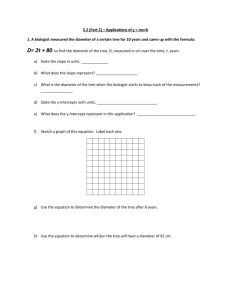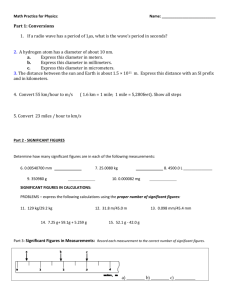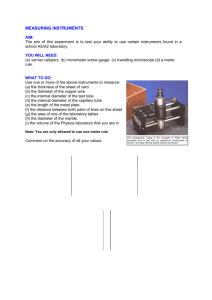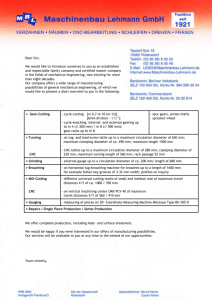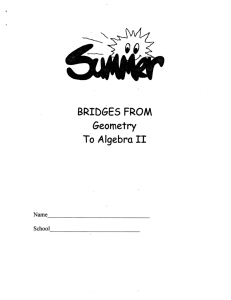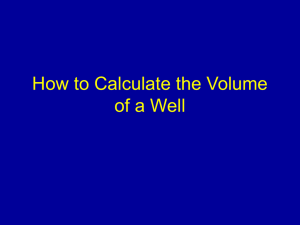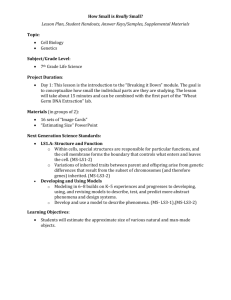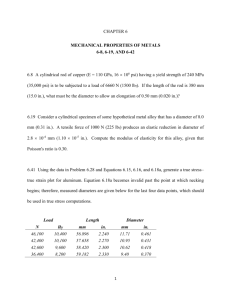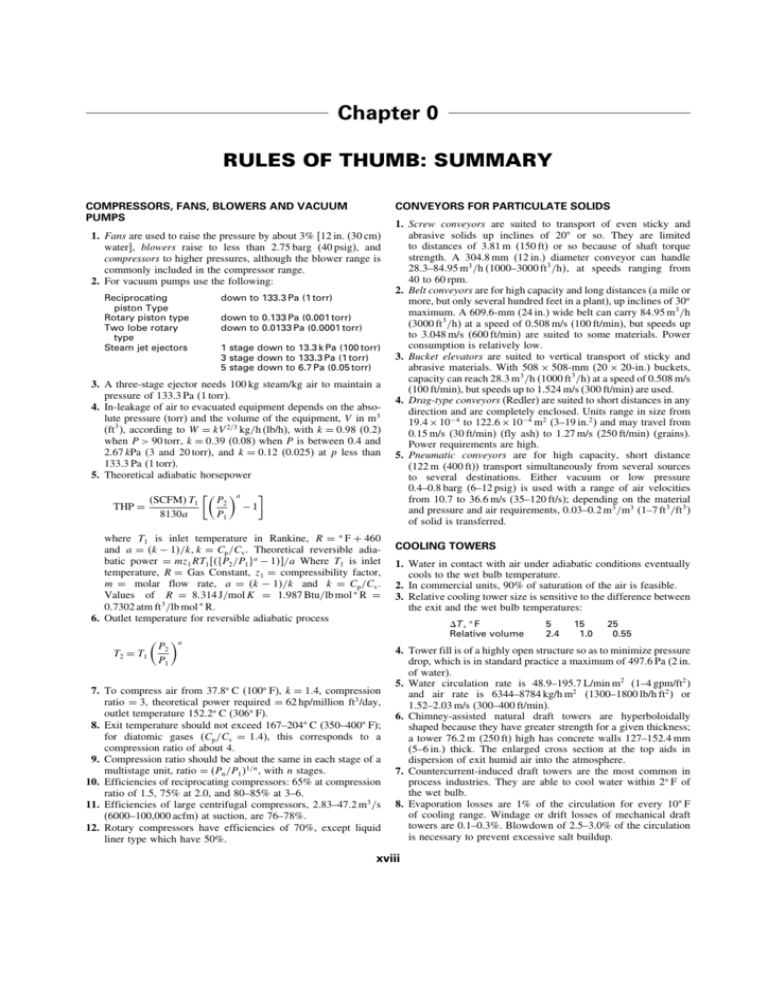
Chapter 0
RULES OF THUMB: SUMMARY
CONVEYORS FOR PARTICULATE SOLIDS
COMPRESSORS, FANS, BLOWERS AND VACUUM
PUMPS
1. Fans are used to raise the pressure by about 3% [12 in. (30 cm)
water], blowers raise to less than 2.75 barg (40 psig), and
compressors to higher pressures, although the blower range is
commonly included in the compressor range.
2. For vacuum pumps use the following:
Reciprocating
piston Type
Rotary piston type
Two lobe rotary
type
Steam jet ejectors
down to 133.3 Pa (1 torr)
down to 0.133 Pa (0.001 torr)
down to 0.0133 Pa (0.0001 torr)
1 stage down to 13.3 k Pa (100 torr)
3 stage down to 133.3 Pa (1 torr)
5 stage down to 6.7 Pa (0.05 torr)
3. A three-stage ejector needs 100 kg steam/kg air to maintain a
pressure of 133.3 Pa (1 torr).
4. In-leakage of air to evacuated equipment depends on the absolute pressure (torr) and the volume of the equipment, V in m3
(ft 3 ), according to W = kV 2/3 kg/h (lb/h), with k = 098 (0.2)
when P > 90 torr, k = 039 (0.08) when P is between 0.4 and
2.67 kPa (3 and 20 torr), and k = 012 (0.025) at p less than
133.3 Pa (1 torr).
5. Theoretical adiabatic horsepower
THP =
SCFM T1
8130a
P2
P1
a
−1
where T1 is inlet temperature in Rankine, R = F + 460
and a = k − 1/k k = Cp /Cv . Theoretical reversible adiabatic power = mz1 RT1 P2 /P1 a − 1/a Where T1 is inlet
temperature, R = Gas Constant, z1 = compressibility factor,
m = molar flow rate, a = k − 1/k and k = Cp /Cv .
Values of R = 8314 J/mol K = 1987 Btu/lb mol R =
07302 atm ft3 /lb mol R.
6. Outlet temperature for reversible adiabatic process
T2 = T1
P2
P1
a
7. To compress air from 37.8 C (100 F), k = 14, compression
ratio = 3, theoretical power required = 62 hp/million ft3 /day,
outlet temperature 152.2 C (306 F).
8. Exit temperature should not exceed 167–204 C (350–400 F);
for diatomic gases (Cp /Cv = 14), this corresponds to a
compression ratio of about 4.
9. Compression ratio should be about the same in each stage of a
multistage unit, ratio = Pn /P1 1/n , with n stages.
10. Efficiencies of reciprocating compressors: 65% at compression
ratio of 1.5, 75% at 2.0, and 80–85% at 3–6.
11. Efficiencies of large centrifugal compressors, 2.83–472 m3 /s
(6000–100,000 acfm) at suction, are 76–78%.
12. Rotary compressors have efficiencies of 70%, except liquid
liner type which have 50%.
1. Screw conveyors are suited to transport of even sticky and
abrasive solids up inclines of 20 or so. They are limited
to distances of 3.81 m (150 ft) or so because of shaft torque
strength. A 304.8 mm (12 in.) diameter conveyor can handle
283–8495 m3 /h 1000–3000 ft3 /h, at speeds ranging from
40 to 60 rpm.
2. Belt conveyors are for high capacity and long distances (a mile or
more, but only several hundred feet in a plant), up inclines of 30
maximum. A 609.6-mm (24 in.) wide belt can carry 8495 m3 /h
(3000 ft3 /h) at a speed of 0.508 m/s (100 ft/min), but speeds up
to 3.048 m/s (600 ft/min) are suited to some materials. Power
consumption is relatively low.
3. Bucket elevators are suited to vertical transport of sticky and
abrasive materials. With 508 × 508-mm (20 × 20-in.) buckets,
capacity can reach 283 m3 /h (1000 ft3 /h) at a speed of 0.508 m/s
(100 ft/min), but speeds up to 1.524 m/s (300 ft/min) are used.
4. Drag-type conveyors (Redler) are suited to short distances in any
direction and are completely enclosed. Units range in size from
194 × 10−4 to 1226 × 10−4 m2 (3–19 in.2 ) and may travel from
0.15 m/s (30 ft/min) (fly ash) to 1.27 m/s (250 ft/min) (grains).
Power requirements are high.
5. Pneumatic conveyors are for high capacity, short distance
(122 m (400 ft)) transport simultaneously from several sources
to several destinations. Either vacuum or low pressure
0.4–0.8 barg (6–12 psig) is used with a range of air velocities
from 10.7 to 36.6 m/s (35–120 ft/s); depending on the material
and pressure and air requirements, 003–02 m3 /m3 (1–7 ft3 /ft3 )
of solid is transferred.
COOLING TOWERS
1. Water in contact with air under adiabatic conditions eventually
cools to the wet bulb temperature.
2. In commercial units, 90% of saturation of the air is feasible.
3. Relative cooling tower size is sensitive to the difference between
the exit and the wet bulb temperatures:
T , F
Relative volume
5
24
15
1.0
25
0.55
4. Tower fill is of a highly open structure so as to minimize pressure
drop, which is in standard practice a maximum of 497.6 Pa (2 in.
of water).
5. Water circulation rate is 48.9–195.7 L/min m2 (1–4 gpm/ft2 )
and air rate is 6344–8784 kg/h m2 (1300–1800 lb/h ft2 ) or
1.52–2.03 m/s (300–400 ft/min).
6. Chimney-assisted natural draft towers are hyperboloidally
shaped because they have greater strength for a given thickness;
a tower 76.2 m (250 ft) high has concrete walls 127–152.4 mm
(5–6 in.) thick. The enlarged cross section at the top aids in
dispersion of exit humid air into the atmosphere.
7. Countercurrent-induced draft towers are the most common in
process industries. They are able to cool water within 2 F of
the wet bulb.
8. Evaporation losses are 1% of the circulation for every 10 F
of cooling range. Windage or drift losses of mechanical draft
towers are 0.1–0.3%. Blowdown of 2.5–3.0% of the circulation
is necessary to prevent excessive salt buildup.
xviii
RULES OF THUMB: SUMMARY
CRYSTALLIZATION FROM SOLUTION
1. Complete recovery of dissolved solids is obtainable by evaporation, but only to the eutectic composition by chilling. Recovery
by melt crystallization also is limited by the eutectic composition.
2. Growth rates and ultimate sizes of crystals are controlled by
limiting the extent of supersaturation at any time.
3. The ratio S = C/Csat of prevailing concentration to saturation
concentration is kept near the range 1.02–1.05.
4. In crystallization by chilling, the temperature of the solution
is kept atmost 1–2 F below the saturation temperature at the
prevailing concentration.
5. Growth rates of crystals under satisfactory conditions are in the
range of 0.1–0.8 mm/h. The growth rates are approximately the
same in all directions.
6. Growth rates are influenced greatly by the presence of impurities
and of certain specific additives, which vary from case to case.
DISINTEGRATION
1. Percentages of material greater than 50% of the maximum size
are about 50% from rolls, 15% from tumbling mills, and 5%
from closed-circuit ball mills.
2. Closed-circuit grinding employs external size classification and
return of oversize for regrinding. The rules of pneumatic
conveying are applied to the design of air classifiers. Closed
circuit is most common with ball and roller mills.
3. Jaw crushers take lumps of several feet in diameter to 102 mm
(4 in.). Stroke rates are 100–300/min. The average feed is
subjected to 8–10 strokes before it becomes small enough to
escape. Gyratory crushers are suited to slabby feeds and make
a more rounded product.
4. Roll crushers are made either smooth or with teeth. A 610-mm
(24-in.) toothed roll can accept lumps of 356 mm (14 in.) diameter. Smooth rolls affect reduction ratios up to about 4. Speeds
are 50–90 rpm. Capacity is about 25% of the maximum, corresponding to a continuous ribbon of material passing through the
rolls.
5. Hammer mills beat the material until it is small enough to pass
through the screen at the bottom of the casing. Reduction ratios
of 40 are feasible. Large units operate at 900 rpm, smaller ones
up to 16,000 rpm. For fibrous materials the screen is provided
with cutting edges.
6. Rod mills are capable of taking feed as large as 50 mm and
reducing it to 300 mesh, but normally the product range is
8–65 mesh. Rods are 25–150 mm in diameter. The ratio of rod
length to mill diameter is about 1.5. About 45% of the mill
volume is occupied by rods. Rotation is at 50–65% of critical.
7. Ball mills are better suited than rod mills to fine grinding. The
charge is of equal weights of 1.5-, 2-, and 3-in. balls for the
finest grinding. The volume occupied by the balls is 50% of
the mill volume. Rotation speed is 70–80% of critical. Ball mills
have a length-to-diameter ratio in the range 1–1.5. Tube mills
have a ratio of 4–5 and are capable of very find grinding. Pebble
mills have ceramic grinding elements, used when contamination
with metal is to be avoided.
8. Roller mills employ cylindrical or tapered surfaces that roll
along flatter surfaces and crush nipped particles. Products of
20–200 mesh are made.
TOWERS
1. Distillation usually is the most economical method of separating
liquids, superior to extraction, adsorption, crystallization, or
others.
xix
2. For ideal mixtures, relative volatility is the ratio of vapor
pressure, 12 = P2 /P1 .
3. Tower operating pressure is most often determined by the
temperature of the available condensing medium, 38–50 C
(100–120 F) if cooling water, or by the maximum allowable reboiler temperature, 10.34 barg (150 psig) steam, 186 C
(366 F) to avoid chemical decomposition/degradation.
4. Sequencing of columns for separating multicomponent
mixtures:
a. Perform the easiest separation first, that is, the one least
demanding of trays and reflux, and leave the most difficult
to the last.
b. When neither relative volatility nor feed concentration vary
widely, remove the components one by one as overhead
products.
c. When the adjacent ordered components in the feed vary
widely in relative volatility, sequence the splits in the order
of decreasing volatility.
d. And when the concentrations in the feed vary widely but
the relative volatilities do not, remove the components in
the order of decreasing concentration in the feed.
5. The economically optimum reflux ratio is about 1.2–1.5 times
the minimum reflux ratio Rm .
6. The economically optimum number of theoretical trays is near
twice the minimum value Nm .
7. The minimum number of trays is found with the Fenske–
Underwood equation:
Nm =
log x/ 1 − xovhd / x/ 1 − xbtms log 8. Minimum reflux for binary or pseudobinary mixtures is given
by the following when separation is essentially complete
(xD 1) and D/F is the ratio of overhead product to feed rate:
Rm D
1
=
F
−1
Rm + 1 D
=
when feed is at the dew point
F
−1
when feed is at the bubble point
9. A safety factor of 10% of the number of trays calculated by
the best means is advisable.
10. Reflux pumps are made at least 10% oversize.
11. The optimum value of the Kremser—Brown absorption factor
A = L/VK is in the range 1.25–2.0.
12. Reflux drums usually are horizontal, with a liquid holdup
of 5 min half-full. A takeoff pot for a second liquid phase,
such as water in hydrocarbon systems, is sized for a linear
velocity of that phase of 0.15 m/s (0.5 ft/s) minimum diameter
of 406.4 mm (16 in.).
13. For towers about 914 mm (3 ft) diameter, add 1219 mm (4 ft)
at the top for vapor disengagement and 1829 mm (6 ft) at the
bottom for liquid level and reboiler return.
14. Limit the tower height to about 53 m (175 ft) maximum
because of wind load and foundation considerations. An additional criterion is that L/D be less than 30 (20 < L/D < 30
often will require special design).
TRAY TOWERS
1. For reasons of accessibility, tray spacings are made 0.5–0.6 m
(20–24 in.).
2. Peak efficiency of trays is at values of the vapor
factor
Fs = v 05 in
the range of 12–15 m/s kg/m3 05
3 05 1–12 ft s lb ft
. This range of Fs establishes the
xx RULES OF THUMB: SUMMARY
3.
4.
5.
6.
7.
8.
diameter of tower. Roughly, linear velocities are 0.6 m/s (2 ft/s)
at moderate pressures and 1.8 m/s (6 ft/s) in vacuum.
Pressure drop per tray is of the order of 747 Pa (3 in. water) or
689.5 Pa (0.1 psi).
Tray efficiencies for distillation of light hydrocarbons and
aqueous solutions are 60–90%; for gas absorption and stripping,
10–20%.
Sieve trays have holes of 6–7 mm (0.25–0.50 in.) diameter, hole
area being 10% of the active cross section.
Valve trays have holes of 38 mm (1.5 in.) diameter, each
provided with a liftable cap, with 130–150 caps per square meter
(12–14 caps per square feet) of active cross section. Valve trays
are usually cheaper than sieve trays.
Bubblecap trays are used only when liquid level must be maintained at low turndown ratio; they can be designed for lower
pressure drop than either sieve or valve trays.
Weir heights are 50 mm (2 in.), weir lengths are about 75%
of trays diameter, and liquid rate a maximum of about
12 m3 /min-m of weir (8 gpm/in. of weir); multi-pass arrangements are used at higher liquid rates.
PACKED TOWERS
1. Structured and random packings are suitable for packed towers
less than 0.9 m (3 ft) when low pressure drop is required.
2. Replacing trays with packing allows greater throughput and
separation in existing tower shells.
3. For gas rates of 142 m3 /min (500 ft3 /min), use 25.4-mm
(1-in.) packing; for 566 m3 /min (2000 ft3 /min) or more use
50-mm (2-in.) packing.
4. Ratio of tower diameter/packing diameter should be >15/1.
5. Because of deformability, plastic packing is limited to 3–4 m
(10–15 ft) and metal packing to 6.0–7.6 m (20–25 ft) unsupported depth.
6. Liquid distributors are required every 5–10 tower diameters
with pall rings and at least every 6.5 m (20 ft) for other types
of dumped packing.
7. Number of liquid distributions should be >32–55/m2 (3–5/ft2 )
in towers greater than 0.9 m (3 ft) diameter and more numerous
in smaller columns.
8. Packed towers should operate near 70% of the flooding rate
(evaluated from Sherwood and Lobo correlation).
9. Height Equivalent to a Theoretical Stage (HETS) for vapor–
liquid contacting is 0.4–0.56 m (1.3–1.8 ft) for 25-mm (1-in.)
pall rings and 0.76–0.9 m (2.5–3.0 ft) for 50-mm (2-in.) pall
rings.
Design Pressure
Drops (cm of
H2 O/m of
packing)
Design Pressure
Drops (in. of
H2 O/ft of
packing)
Absorbers and
Regenerators
(non-foaming
systems)
Absorbers and
Regenerators
Atmospheric/Pressure
Stills and
Fractionators
2.1–3.3
0.25–0.40
0.8–2.1
0.10–0.25
3.3–6.7
0.40–0.80
Vacuum Stills and
Fractionators
0.8–3.3
0.10–0.40
Maximum value
8.33
1.0
10. Generalized
pressure drops
DRIVERS AND POWER RECOVERY EQUIPMENT
1. Efficiency is greater for larger machines. Motors, 85–95%;
steam turbines, 42–78%; gas engines and turbines, 28–38%.
2. For under 74.6 kW (100 hp), electric motors are used almost
exclusively. They are made for up to 14,900 kW (20,000 hp).
3. Induction motors are most popular. Synchronous motors are
made for speeds as low as 150 rpm and are thus suited, for
example, for low-speed reciprocating compressors, but are not
made smaller than 50 hp. A variety of enclosures are available,
from weather-proof to explosion-proof.
4. Steam turbines are competitive above 76.6 kW (100 hp). They
are speed-controllable. They are frequently used as spares in
case of power failure.
5. Combustion engines and turbines are restricted to mobile and
remote locations.
6. Gas expanders for power recovery may be justified at capacities
of several hundred hp; otherwise any pressure reduction in a
process is done with throttling valves.
7. The following useful definitions are given:
shaft power =
theoretical power to pump fluid (liquid or gas)
efficiency of pump or compressor sh
drive power =
shaft power
efficiency of drive dr
Overall efficiency ov = sh · dr
DRYING OF SOLIDS
1. Drying times range from a few seconds in spray dryers to 1 h
or less in rotary dryers and up to several hours or even several
days in tunnel shelf or belt dryers.
2. Continuous tray and belt dryers for granular material of natural
size or pelleted to 3–15 mm have drying times in the range of
10–200 min.
3. Rotary cylindrical dryers operate with superficial air velocities
of 1.52–3.05 m/s (5–10 ft/s), sometimes up to 10.67 m/s (35 ft/s)
when the material is coarse. Residence times are 5–90 min.
Holdup of solid is 7–8%. An 85% free cross section is taken
for design purposes. In countercurrent flow, the exit gas is
10–20 C above the solid; in parallel flow, the temperature of
the exit solid is 100 C. Rotation speeds of about 4 rpm are used,
but the product of rpm and diameter in feet is typically between
15 and 25.
4. Drum dryers for pastes and slurries operate with contact times
of 3–12 s, and produce flakes 1–3 mm thick with evaporation
rates of 15–30 kg/m2 -h. Diameters are in the range of 1.5–5.0 ft;
and rotation rate is 2–10 rpm. The greatest evaporative capacity
is of the order of 1360.7 kg/h (3000 lb/h) in commercial units.
5. Pneumatic conveying dryers normally take particles 1–3 mm
diameter but up to 10 mm when the moisture is mostly on
the surface. Air velocities are 10–30 m/s. Single-pass residence
times are 0.5–3.0 s, but with normal recycling the average residence time is brought up to 60 s. Units in use range from 0.2 m
in diameter by 1 m long to 0.3 m in diameter by 38 m long. Air
requirement is several SCFM per lb of dry product/h.
6. Fluidized bed dryers work best on particles of a few tenths of
a mm in diameter, but particles of up to 4 mm in diameter have
been processed. Gas velocities of twice the minimum fluidization velocity are a safe prescription. In continuous operation,
drying times of 1–2 min are enough, but batch drying of some
pharmaceutical products employs drying times of 2–3 h.
7. Spay dryers: Surface moisture is removed in about 5 s, and
most drying is completed in less than 60 s. Parallel flow of
RULES OF THUMB: SUMMARY
air and stock is most common. Atomizing nozzles have openings 3–3.8 mm (0.012–0.15 in.) and operate at pressures of
21–276 bar (300–4000 psi). Atomizing spray wheels rotate at
speeds of 20,000 rpm with peripheral speeds of 76.2–183 m/s
(250–600 ft/s). With nozzles, the length-to-diameter ratio of the
dryer is 4–5; with spray wheels, the ratio is 0.5–1.0. For the
final design, the experts say, pilot tests in a unit of 2 m diameter
should be made.
EVAPORATORS
1. Long tube vertical evaporators with either natural or
forced circulation are most popular. Tubes are 19–63 mm
(0.75–24.8 in.) in diameter and 3.66–9.14 m (12–30 ft) long.
2. In forced circulation, linear velocities in the tubes are in the
range of 4.57–6.09 m/s (15–20 ft/s).
3. Elevation of boiling point by dissolved solids results in temperature differences of 3–10 F between solution and saturated
vapor.
4. When the boiling point rise is appreciable, the economic number
of effects in series with forward feed is 4–6.
5. When the boiling point rise is small, minimum cost is obtained
with 8–10 effects in series.
6. In backward feed the more concentrated solution is heated with
the highest temperature steam so that heating surface is lessened, but the solution must be pumped between stages.
7. The steam economy of an N -stage battery is approximately
0.8 N -lb evaporation/lb of outside steam.
8. Interstage steam pressures can be boosted with steam jet
compressors of 20–30% efficiency or with mechanical compressors of 70–75% efficiency.
EXTRACTION, LIQUID–LIQUID
1. The dispersed phase should be the one that has the higher
volumetric rate, except in equipment subject to back-mixing
where it should be the one with the smaller volumetric rate.
It should be the phase that wets the material of construction
less well. Since the holdup of continuous phase is greater, that
phase should be made up of the less expensive or less hazardous
material.
2. There are no known commercial applications of reflux to extraction processes, although the theory is favorable.
3. Mixer–settler arrangements are limited to at most five stages.
Mixing is accomplished with rotating impellers or circulating
pumps. Settlers are designed on the assumption that droplet
sizes are about 150 m in diameter. In open vessels, residence
times of 30–60 min or superficial velocities of 0.15–0.46 m/min
(0.5–1.5 ft/min) are provided in settlers. Extraction-stage efficiencies commonly are taken as 80%.
4. Spray towers as tall as 6–12 m (20–40 ft) cannot be depended
on to function as more than a single stage.
5. Packed towers are employed when 5–10 stages suffice. Pall
rings 25–38 mm (1–1.5 in.) in size are best. Dispersed-phase
loadings should not exceed 102 m3 /min-m2 (25 gal./min-ft2 ).
And HETS of 1.5–3.0 m (5–10 ft) may be realized. The
dispersed phase must be redistributed every 1.5–2.1 m (5–7 ft).
Packed towers are not satisfactory when the surface tension is
more than 10 dyne/cm.
6. Sieve tray towers have holes of only 3–8 mm diameter. Velocities through the holes are kept below 0.24 m/s (0.8 ft/s) to
avoid formation of small drops. Re-dispersion of either phase at
each tray can be designed for. Tray spacings are 152–600 mm
(6–24 in.). Tray efficiencies are in the range of 20–30%.
xxi
7. Pulsed packed and sieve tray towers may operate at frequencies
of 90 cycles/min and amplitudes of 6–25 mm. In large-diameter
tower, HETS of about 1 m has been observed. Surface tensions
as high as 30–40 dyn/cm have no adverse effect.
8. Reciprocating tray towers can have holes of 150 mm (9/16 in.)
diameter, 50–60% open area, stroke length 190 mm (0.75 in.),
100–150 strokes/min, and plate spacing normally 50 mm (2 in.)
but in the range of 25.0–150 mm (1–6 in.). In a 760-mm (30in.) diameter tower, HETS is 500–650 mm (20–25 in.) and
throughput is 137 m3 /min-m2 (2000 gal./h-ft2 ). Power requirements are much less than those of pulsed towers.
9. Rotating disk contractors or other rotary agitated towers realize
HETS in the range of 0.1–0.5 m (0.33–1.64 ft). The especially
efficient Kuhni with perforated disks of 40% free cross section
has HETS of 0.2 m (0.66 ft) and a capacity of 50 m3 /m2 -h
(164 ft3 /ft2 -h).
FILTRATION
1. Processes are classified by their rate of cake buildup in a
laboratory vacuum leaf filter: rapid, 0.1–10.0 cm/s; medium,
0.1–10.0 cm/min; and slow, 0.1–10.0 cm/h.
2. Continuous filtration should not be attempted if 1/8 in. cake
thickness cannot be formed in less than 5 min.
3. Rapid filtering is accomplished with belts, top feed drums, or
pusher centrifuges.
4. Medium rate filtering is accomplished with vacuum drums or
disks or peeler centrifuges.
5. Slow-filtering slurries are handled in pressure filters or sedimenting centrifuges.
6. Clarification with negligible cake buildup is accomplished with
cartridges, precoat drums, or sand filters.
7. Laboratory tests are advisable when the filtering surface is
expected to be more than a few square meters, when cake
washing is critical, when cake drying may be a problem, and
when precoating may be needed.
8. For finely ground ores and minerals, rotary drum filtration rates
may be 15,000 lb/day-ft2 at 20 rev/h and 18–25 in. Hg vacuum.
9. Coarse solids and crystals may be filtered at rates of
6000 lb/day-ft2 at 20 rev/h and 2–6 in. Hg vacuum.
FLUIDIZATION OF PARTICLES WITH GASES
1. Properties of particles that are conducive to smooth fluidization
include rounded or smooth shape, enough toughness to resist
attrition, sizes in the range of 50–500 m diameter, and a spectrum
of sizes with ratio of largest to smallest in the range of 10–25.
2. Cracking catalysts are members of a broad class characterized
by diameters of 30–150 m, density of 1.5 g/ml or so, and
appreciable expansion of the bed before fluidization sets in,
minimum bubbling velocity greater than minimum fluidizing
velocity, and rapid disengagement of bubbles.
3. The other extreme of smoothly fluidizing particles are typified
by coarse sand and glass beads, both of which have been
the subject of much laboratory investigation. Their sizes are in
the range of 150–500 m, densities 1.5–4.0 g/ml, have small
bed expansion and about the same magnitudes of minimum
bubbling and minimum fluidizing velocities, and they also have
rapidly disengaging bubbles.
4. Cohesive particles and large particles of 1 mm or more do not
fluidize well and usually are processed in other ways.
5. Rough correlations have been made of minimum fluidization velocity, minimum bubbling velocity, bed expansion, bed
level fluctuation, and disengaging height. Experts recommend,
however, that any real design be based on pilot-plant work.
xxii RULES OF THUMB: SUMMARY
6. Practical operations are conducted at two or more multiples
of the minimum fluidizing velocity. In reactors, the entrained
material is recovered with cyclones and returned to process.
In driers, the fine particles dry most quickly so the entrained
material need not be recycled.
5. Optimum thickness varies with temperature: 12.7 mm (0.5 in.)
at 95 C 200 F), 25.4 mm (1.0 in.) at 200 C 400 F, 32 mm
(1.25 in.) at 315 C 600 F).
6. Under windy conditions, 12.1 km/h (7.5 miles/h), 10–20%
greater thickness of insulation is justified.
HEAT EXCHANGERS
MIXING AND AGITATION
1. For conservative estimate set F = 09 for shell and tube
exchangers with no phase changes, q = UAFTlm . When T
at exchanger ends differ greatly then check F , reconfigure if
F is less than 0.85.
2. Take true countercurrent flow in a shell-and-tube exchanger
as a basis.
3. Standard tubes are 19.0 mm (3/4 in.) outer diameter (OD),
25.4 mm (1 in.) triangular spacing, 4.9 m (16 ft) long.
A shell of 300 mm (1 ft) diameter accommodates 93 m
(100 ft2 );
600 mm (2 ft) diameter accommodates 372 m2 400 ft2 ;
900 mm (3 ft) diameter accommodates 102 m2 (1100 ft2 ).
2
4. Tube side is for corrosive, fouling, scaling, and high-pressure
fluids.
5. Shell side is for viscous and condensing fluids.
6. Pressure drops are 0.1 bar (1.5 psi) for boiling and 0.2–0.62 bar
(3–9 psi) for other services.
7. Minimum temperature approach is 10 C20 F for fluids and
5 C 10 F) for refrigerants.
8. Cooling water inlet temperature is 30 C 90 F), maximum
outlet temperature 49 C 120 F).
9. Heat-transfer coefficients for estimating purposes, W/m2 C
(Btu/h-ft2 - F): water to liquid, 850 (150); condensers, 850
(150); liquid to liquid, 280 (50); liquid to gas, 60 (10); gas to
gas, 30 (5); and reboiler 1140 (200). Maximum flux in reboiler
is 315 kW/m2 (10,000 Btu/h-ft2 ). When phase changes occur,
use a zoned analysis with appropriate coefficients for each
zone.
10. Double-pipe exchanger is competitive at duties requiring
93–186 m2 (100–200 ft2 ).
11. Compact (plate and fin) exchangers have 1150 m2 /m3
350 ft2 /ft3 ), and about 4 times the heat transfer per cut of
shell-and-tube units.
12. Plate and frame exchangers are suited to high sanitation
services and are 25–50% cheaper in stainless steel construction
than shell-and-tube units.
13. Air coolers: Tubes are 0.75–1.00 in. OD., total finned
surface 15–20 ft2 /ft 2 bare surface, U = 450–570 W/m2 C
2
(80–100 Btu/hr-ft (bare surface)- F). Minimum approach
temperature = 22 C 40 F. Fan input power = 14–36 kW/
MJ/h 2–5 hp/1000 Btu/h.
14. Fired heaters: radiant rate, 376 kW/m2 (12,000 Btu/h-ft2 ),
convection rate, 125 kW/m2 (4000 Btu/h-ft2 ); cold oil tube
velocity = 1.8 m/s (6 ft/s); approximately equal heat transfer in
the two sections; thermal efficiency, 70–75%; flue gas temperature, 140–195 C (250–350 F) above feed inlet; and stack
gas temperature, 345–510 C 650–950 F).
INSULATION
1. Up to 345 C 650 F), 85% magnesia is used.
2. Up to 870–1040 C 1600–1900 F), a mixture of asbestos and
diatomaceous earth is used.
3. Ceramic refractories at higher temperatures.
4. Cryogenic equipment −130 C −200 F) employs insulations
with fine pores of trapped air, for example, PerliteTM .
1. Mild agitation is obtained by circulating the liquid with
an impeller at superficial velocities of 30.48–60.9 mm/s
(0.1–0.2 ft/s), and intense agitation at 213.4–304.8 mm/s (0.7–
1.0 ft/s).
2. Intensities of agitation with impellers in baffled tanks are
measured by power input, hp/1000 gal., and impeller tip speeds:
Operation
Blending
hp/1000 gal.
0.2–0.5
Tip speed
(ft/min)
Tip speed
(m/s)
Homogeneous
reaction
0.5–1.5
7.5–10
0.038–0.051
Reaction with
heat transfer
Liquid–liquid
mixtures
Liquid–gas
mixtures
1.5–5.0
10–15
0.051–0.076
5
15–20
0.076–0.10
5–10
15–20
0.076–0.10
Slurries
10
3. Proportions of a stirred tank relative to the diameter D:
liquid level = D; turbine impeller diameter = D/3; impeller
level above bottom = D/3; impeller blade width = D/15; four
vertical baffles with width = D/10.
4. Propellers are made with a maximum of 457.2-mm (18-in.)
turbine impellers to 2.74 m (9 ft).
5. Gas bubbles sparged at the bottom of the vessel will result
in mild agitation at a superficial gas velocity of 0.0051 m/s
(1 ft/min), severe agitation at 0.02 m/s (4 ft/min).
6. Suspension of solids with a settling velocity of 0.009 m/s
(0.03 ft/s) is accomplished with either turbine or propeller
impellers, but when the settling velocity is above 0.05 m/s
(0.15 ft/s) intense agitation with a propeller is needed.
7. Power to drive a mixture of a gas and a liquid can be 25–50%
less than the power to drive the liquid alone.
8. In-line blenders are adequate when a second contact time is
sufficient, with power inputs of 0.1–0.2 hp/gal.
PARTICLE SIZE ENLARGEMENT
1. The chief methods of particle size enlargement are compression into a mold, extrusion through a die followed by cutting
or breaking to size, globulation of molten material followed
by solidification, agglomeration under tumbling or otherwise
agitated conditions with or without binding agents.
2. Rotating drum granulators have length-to-diameter ratios
of 2–3, speeds 10–20 rpm, pitch as much as 10 . Size is controlled
by speed, residence time, and amount of binder; 2–5 mm diameter is common.
3. Rotary disk granulators produce a more nearly uniform product
than drum granulators: fertilizer, 1.5–3.5 mm diameter; iron ore
10–25 mm diameter.
4. Roll compacting and briquetting is done with rolls ranging
from 130 mm diameter by 50 mm wide to 910 mm diameter
by 550 mm wide. Extrudates are made 1–10 mm thick and are
broken down to size for any needed processing, such as feed to
tableting machines or to dryers.
RULES OF THUMB: SUMMARY
5. Tablets are made in rotary compression machines that convert
powders and granules into uniform sizes. The usual maximum
diameter is about 38.1 mm (1.5 in.), but special sizes up to
101.6 mm (4 in.) diameter are possible. Machines operate at
100 rpm or so and make up to 10,000 tablets/min.
6. Extruders make pellets by forcing powders, pastes, and melts
through a die followed by cutting. A 203.2-mm (8-in.) screw
has a capacity of 907.2 kg/h (2000 lb/h) of molten plastic and
is able to extrude tubing at 0.76–1.52 m/s (150–300 ft/min) and
to cut it into sizes as small as washers at 8000/min. Ring pellet
extrusion mills have hole diameters of 1.6–32 mm. Production
rates are in the range of 30–200 lb/h-hp.
7. Prilling towers convert molten materials into droplets and allow
them to solidify in contact with an air stream. Towers as high
as 60 m (196.9 ft) are used. Economically the process becomes
competitive with other granulation processes when a capacity
of 200–400 tons/day is reached. Ammonium nitrate prills, for
example, are 1.6–3.5 mm diameter in the 5–95% range.
8. Fluidized bed granulation is conducted in shallow beds 304.8–
609.6 mm (12–24 in.) deep at air velocities of 0.1–2.5 m/s or
3–10 times the minimum fluidizing velocity, with evaporation rates of 0005–10 kg/m2 s. One product has a size range
0.7–2.4 mm diameter.
PIPING
1. Line velocities (v) and pressure drops P: (a) For a
liquid pump discharge, v = 5 + D/3 ft/s and P = 045 bar/
100 m 20 psi/100 ft; (b) For liquid pump suction, v =
13 + D/6 ft/s P = 009 bar/100 m 04 psi/100 ft); (c) for
steam or gas flow: v = 20D ft/s and P = 0113 bar/100 m
(0.5 psi/100 ft), D = diameter of pipe in inches.
2. Gas/steam line velocities = 61 m/s 200 ft/s) and pressure
drop = 01 bar/100 m 05 psi/100 ft).
3. In preliminary estimates set line pressure drops for an equivalent length of 30.5 m (100 ft) of pipe between each of piece of
equipment.
4. Control valves require at least 0.69 bar (10 psi) pressure drop for
good control.
5. Globe valves are used for gases, control and wherever tight
shut-off is required. Gate valves are for most other services.
6. Screwed fittings are used only on sizes 38 mm (1.5 in.) or less,
flanges or welding used otherwise.
7. Flanges and fittings are rated for 10, 20, 40, 103, 175 bar (150,
300, 600, 900, 1500, or 2500 psig).
8. Approximate schedule number required = 1000 P/S, where P
is the internal pressure psig and S is the allowable working
stress [about 690 bar (10,000 psi)] for A120 carbon steel at
260 C 500 F). Schedule (Sch.) 40 is most common.
PUMPS
1. Power for pumping liquids: kW = 167Flow m3 /min
Pbar/hp = Flow gpm P psi/1 714 =
fractional efficiency).
2. Net positive suction head (NPSH) of a pump must be in excess
of a certain number, depending upon the kind of pumps and the
conditions, if damage is to be avoided. NPSH = (pressure at
the eye of the impeller-vapor pressure)/(g). Common range is
1.2–6.1 m (4–20 ft) of liquid.
3. Specific speed Ns = rpmgpm05 /head in ft075 . Pump may
be damaged if certain limits of Ns are exceeded, and efficiency
is best in some ranges.
4. Centrifugal pumps: Single stage for 0057–189 m3 /min
(15–5000 gpm), 152 m (500 ft) maximum head; multistage
xxiii
for 0076–416 m3 /min 20–11000 gpm, 1675 m (5500 ft)
maximum head. Efficiency: 45% at 0378 m3 /min (100 gpm),
70% at 189 m3 /min (500 gpm), and 80% at 378 m3 /min
(10,000 gpm).
5. Axial pumps for 0.076–378 m3 /min (20–100,000 gpm), 12 m
(40 ft) head, 65–85% efficiency.
6. Rotary pumps for 0.00378–189 m3 /min (1–5000 gpm), 15,200 m
(50,000 ft) head, 50–80% efficiency.
7. Reciprocating pumps for 0.0378–378 m3 /min (10–10,000 gpm),
300 km (1,000,000 ft) maximum head. Efficiency: 70% at 7.46 kW
(10 hp), 85% at 37.3 kW (50 hp), and 90% at 373 kW (500 hp).
REACTORS
1. The rate of reaction in every instance must be established in the
laboratory, and the residence time or space velocity and product
distribution eventually must be found from a pilot plant.
2. Dimensions of catalyst particles are 0.1 mm (0.004 in.)
in fluidized beds, 1 mm in slurry beds, and 2–5 mm
(0.078–0.197 in.) in fixed beds.
3. The optimum proportions of stirred tank reactors are with
liquid level equal to the tank diameter, but at high pressures
slimmer proportions are economical.
4. Power input to a homogeneous reaction stirred tank is
0.1–03 kw/m3 (0.5–1.5 hp/1000 gal.) but three times this
amount when heat is to be transferred.
5. Ideal CSTR (continuous stirred tank reactor) behavior is
approached when the mean residence time is 5–10 times the
length needed to achieve homogeneity, which is accomplished
with 500–2000 revolutions of a properly designed stirrer.
6. Batch reactions are conducted in stirred tanks for small daily
production rates or when the reaction times are long or when
some condition such as feed rate or temperature must be
programed in some way.
7. Relatively slow reactions of liquids and slurries are conducted
in continuous stirred tanks. A battery of four or five in series
is most economical.
8. Tubular flow reactors are suited to high production rates at
short residence times (seconds or minutes) and when substantial heat transfer is needed. Embedded tubes or shell-and-tube
constructions then are used.
9. In granular catalyst packed reactors, the residence time distribution is often no better than that of a five-stage CSTR battery.
10. For conversions under about 95% of equilibrium, the performance of a five-stage CSTR battery approaches plug flow.
11. The effect of temperature on chemical reaction rate is to double
the rate every 10 C.
12. The rate of reaction in a heterogeneous system is more often
controlled by the rate of heat or mass transfer than by the
chemical reaction kinetics.
13. The value of a catalyst may be to improve selectivity more
than to improve the overall reaction rate.
REFRIGERATION
1. A ton of refrigeration is the removal of 12,700 kJ/h
(12,000 Btu/h) of heat.
2. At various temperature levels: −18 to −10 C (0–50 F), chilled
brine and glycol solutions; −45 to −10 C (−50 to −40 F),
ammonia, Freon, and butane; −100 to −45 C (−150 to −50 F),
ethane or propane.
3. Compression refrigeration with 38 C (100 F) condenser
requires kW/tonne (hp/ton) at various temperature levels; 0.93
(1.24) at −7 C (20 F), 1.31 (1.75) at −18 C (0 F); 2.3 (3.1)
at −40 C (−40 F); 3.9 (5.2) at −62 C (−80 F).
xxiv RULES OF THUMB: SUMMARY
4. Below −62 C (−80 F), cascades of two or three refrigerants
are used.
5. In single-stage compression, the compression ratio is limited
to 4.
6. In multistage compression, economy is improved with interstage flashing and recycling, the so-called “economizer operation.”
7. Absorption refrigeration: ammonia to −34 C (−30 F) and
lithium bromide to 7 C (45 F) is economical when waste steam
is available at 0.9 barg (12 psig).
SIZE SEPARATION OF PARTICLES
1. Grizzlies that are constructed of parallel bars at appropriate
spacings are used to remove products larger than 50 mm in
diameter.
2. Revolving cylindrical screens rotate at 15–20 rpm and below the
critical velocity; they are suitable for wet or dry screening in the
range of 10–60 mm.
3. Flat screens are vibrated, shaken, or impacted with bouncing
balls. Inclined screens vibrate at 600–7000 strokes/min and are
used for down to 38 m, although capacity drops off sharply
below 200 m. Reciprocating screens operate in the range of
30–1000 strokes/min and handle sizes to 0.25 mm at the higher
speeds.
4. Rotary sifters operate at 500–600 rpm and are suited to a range
of 12 mm–50 m.
5. Air classification is preferred for fine sizes because screens of
150 mesh and finer are fragile and slow.
6. Wet classifiers mostly are used to make two product size
ranges, oversize and undersize, with a break commonly in the
range between 28 and 200 mesh. A rake classifier operates at
about 9 strokes/min when making separation at 200 mesh and
32 strokes/min at 28 mesh. Solids content is not critical, and
that of the overflow may be 2–20% or more.
7. Hydrocyclones handle up to 600 ft3 /min and can remove particles in the range of 300–5 m from dilute suspensions. In one
case, a 20-in. diameter unit had a capacity of 1000 gpm with a
pressure drop of 5 psi and a cutoff between 50 and 150 m.
UTILITIES, COMMON SPECIFICATIONS
1. Steam: 1–2 bar (15–30 psig), 121–135 C (250–275 F); 10 barg
(150 psig), 186 C (366 F); 27.6 barg (400 psig), 231 C
(448 F); 41.3 barg (600 psig), 252 C (488 F) or with 55–85 C
(100–150 F) superheat.
2. Cooling water: For design of cooling tower use, supply at
27–32 C (80–90 F); from cooling tower, return at 45–52 C
(115–125 F); return seawater at 43 C (110 F); return tempered
water or steam condensate above 52 C (125 F).
3. Cooling air supply at 29–35 C (85–95 F); temperature approach
to process, 22 C (40 F).
4. Compressed air at 3.1 (45), 10.3 (150), 20.6 (300), or 30.9 barg
(450 psig) levels.
5. Instrument air at 3.1 barg (45 psig), −18 C (0 F) dew point.
6. Fuels: gas of 37200 kJ/m3 (1000 Btu/SCF) at 0.35–0.69 barg
(5–10 psig), or up to 1.73 barg (25 psig) for some types of
burners; liquid at 398 GJ/m3 (6 million British Thermal unit
per barrel).
7. Heat-transfer fluids: petroleum oils below 315 C (600 F),
Dowtherms below 400 C (750 F), fused salts below 600 C
(1100 F), and direct fire or electricity above 232 C (450 F).
8. Electricity: 0.75–74.7 kW (1–100 hp), 220–550 V; 149–1864 kW
(200–2500 hp), 2300–4000 V.
VESSELS (DRUMS)
1. Drums are relatively small vessels to provide surge capacity
or separation of entrained phases.
2. Liquid drums are usually horizontal.
3. Gas/liquid phase separators are usually vertical.
4. Optimum length/diameter = 3, but the range 2.5–5.0 is
common.
5. Holdup time is 5 min half-full for reflux drums and
gas/liquid separators, 5–10 min for a product feeding another
tower.
6. In drums feeding a furnace, 30 min half-full drum is allowed.
7. Knockout drums placed ahead of compressors should hold
no less than 10 times the liquid volume passing through per
minute.
8. Liquid/liquid separators are designed for a setting velocity of
0.85–1.27 mm/s (2–3 in./min).
9. Gas velocity in gas/liquid separators, v = k L /V − 1 m/s
(ft/s), with k = 011 (0.35) for systems with a mesh deentrainer
and k = 00305 (0.1) without a mesh deentrainer.
10. Entrainment removal of 99% is attained with 102–305 mm
(4–12 in.) mesh pad thickness; 152.5 mm (6 in.) thickness is
popular.
11. For vertical pads, the value of the coefficient in step 9 is
reduced by a factor of 2/3.
12. Good performance can be expected at velocities of 30–100%
of those calculated with the given k; 75% is popular.
13. Disengaging spaces of 152–457 mm (6–18 in.) ahead of the pad
and 305 mm (12 in.) above the pad are suitable.
14. Cyclone separators can be designed for 95% collection of
5-m particles, but usually only droplets greater than 50 m
need be removed.
VESSEL (PRESSURE)
1. Design temperature between −30 and 345 C is 25 C (−20 F
and 650 F if 50 F) above maximum operating temperature;
higher safety margins are used outside the given temperature
range.
2. The design pressure is 10% or 0.69–1.7 bar (10–25 psi) over
the maximum operating pressure, whichever is greater. The
maximum operating pressure, in turn, is taken as 1.7 bar (25 psi)
above the normal operation.
3. Design pressures of vessels operating at 0–0.69 barg (0–10 psig)
and 95–540 C (200–1000 F) are 2.76 barg (40 psig).
4. For vacuum operation, design pressures are 1 barg (15 psig) and
full vacuum.
5. Minimum wall thickness for rigidity: 6.4 mm (0.25 in.) for
1.07 m (42 in.) diameter and under, 8.1 mm (0.32 in.) for
1.07–1.52 m (42–60 in.) diameter, and 9.7 mm (0.38 in.) for over
1.52 m (60 in.) diameter.
6. Corrosion allowance 8.9 mm (0.35 in.) for known corrosive
conditions, 3.8 mm (0.15 in.) for noncorrosive streams, and
1.5 mm (0.06 in.) for steam drums and air receivers.
7. Allowable working stresses are one-fourth the ultimate strength
of the material.
8. Maximum allowable stress depends sharply on temperature
Temperature ( F)
−20–650
750
850 1,000
−30–345
400
455 540
( C)
Low-alloy steel, SA 203 (psi)
18,759 15,650 9,550 2,500
(bar)
1,290 1,070
686 273
Type 302 stainless (psi)
18,750 18,750 15,950 6,250
(bar)
1,290 1,290 1,100 431
RULES OF THUMB: SUMMARY
xxv
6. A 30-day capacity often is specified for raw materials and
products but depends on connecting transportation equipment
schedules.
7. Capacities of storage tanks are at least 1.5 times the size
of connecting transportation equipment; for instance, 284-m3
(7500 gal.) tanker trucks, 130-m3 (34,500 gal.) rail cars, and
virtually unlimited barge and tanker capacities.
VESSELS (STORAGE TANKS)
3
1. For less than 38 m (1000 gal.), use vertical tanks on legs.
2. For 3.8–38 m3 (1000–10,000 gal.), use horizontal tanks on
concrete supports.
3. Beyond 38 m3 (10,000 gal.) use vertical tanks on concrete foundations.
4. Liquids subject to breathing losses may be stored in tanks with
floating or expansion roofs for conservation.
5. Freeboard is 15% below 19 m3 (500 gal.) and 10% above
19 m3 (500 gal.) capacity.
Source: The above mentioned rules of thumb have been adapted
from Walas, S.M., Chemical Process Equipment: Selection and
Design, copyright 1988 with permission from Elsevier, all rights
reserved.
Physical Property Heuristics
Units
Heat Capacity
Density
Latent Heat
Thermal Conductivity
Viscosity
kJ/kg C
kg/m3
kJ/kg
W/m C
kg/ms
Prandtl No.
Liquids
Liquids
Gases
Gases
Gases
Water
4.2
1000
1200–2100
0.55–0.70
0 C 18 × 10−3
50 C 57 × 10−4
100 C 28 × 10−4
200 C 14 × 10−4
1–15
Organic Material
1.0–2.5
700–1500
200–1000
0.10–0.20
Wide Range
Steam
2.0
Air
1.0
1.29 at STP
Organic Material
2.0–4.0
0.025–0.07
10–30 × 10−6
0.025–0.05
20–50 × 10−6
0.02–0.06
10–30 × 10−6
10–1000
1.0
0.7
0.7–0.8
(Source: Turton, R. et al., Analysis, Synthesis, and Design of Chemical Processes, Prentice Hall International Series, 2001.)
Typical Physical Property Variations with Temperature and Pressure
Liquids
Liquids
Gases
Property
Density
Temperature
l ∝ Tc − T03
Pressure
Negligible
Viscosity
l = AeB/T
Negligible
Vapor Pressure
P ∗ = aeb/T +c
–
Temperature
g = MW P/ZRT
T 15
g T + 147Tb –
Gases
Pressure
g = MW P/ZRT
Significant only for >10 bar
–
Note: T is temperature (K), Tc is the critical Temperature (K), Tb is the normal boiling point (K), MW is
molecular weight, P is pressure, Z is compressibility, R is the gas constant, and P ∗ is the vapor pressure.
(Source: Turton, R. et al., Analysis, Synthesis, and Design of Chemical Processes, Prentice Hall International Series, 2001.)
Capacities of Process Units in Common Usagea
Process unit
Horizontal Vessel
Vertical Vessel
Towers
Capacity Unit
Maximum Value
Minimum Value
Comment
L/D typically 2–5
Pressure (bar)
400
Vacuum
Temper. ( C)
Height (m)
Diameter (m)
L/D
400b
10
2
5
−200
2
0.3
2
Pressure (bar)
400
400
Temperature ( C)
Height (m)
Diameter (m)
L/D
400b
10
2
5
−200
2
0.3
2
Pressure (bar)
400
Vacuum
Temperature ( C)
Height (m)
Diameter (m)
L/D
400
50
4
30
b
−200
2
0.3
2
L/D typically 2–5
Normal Limits
Diameter
0.5
1.0
2.0
4.0
L/D
3.0–40c
2.5–30c
1.6–23c
1.8–13c
xxvi RULES OF THUMB: SUMMARY
Pumps
Reciprocating
Powerd (kW)
Pressure (bar)
Powerd (kW)
Pressure (bar)
Powerd (kW)
Pressure (bar)
250
1,000
150
300
250
300
Powerd (kW)
Powerd (kW)
8,000
1,000
50
50
Powere (kW)
Powere (kW)
Powere (kW)
Powere (kW)
15,000
15,000
15,000
15,000
<1
100
10
10
Process Heaters
Duty (MJ/h)
500,000
Heat Exchangers
Area (m2 )
Tube Dia. (m)
Length (m)
Pressure (bar)
Temperature ( C)
Rotary and Positive
Displacement
Centrifugal
Compressors
Axial, Centrifugal + Recipr.
Rotary
Drives for Compressors
Electric
Steam Turbine
Gas Turbine
Internal Combustion Eng.
1,000
0.0254
6.5
150
400b
<01
<01
<01
10,000
Duties different for reactive
heaters/furnaces.
10
0.019
2.5
Vacuum
−200
For Area < 10 m2 use
double-pipe exchanger.
For 150<P<400 bar
need special design.
a
Most of the limits for equipment sizes shown here correspond to the limits used in the costing program (CAPCOST.BAS).
Maximum temperature and pressure are related to the materials of construction and may differ from values shown here.
For 20<L/D<30 special design may be required. Diameter up to 7 m possible but over 4 m must be fabricated on site.
d
Power values refer to fluid/pumping power.
e
Power values refer to shaft power.
(Source: Turton, R. et al., Analysis, Synthesis, and Design of Chemical Processes, Prentice Hall International Series, 2001.)
b
c
Effect of Typical Materials of Construction on Product Color, Corrosion, Abrasion, and Catalytic Effects
Metals
Material
Carbon Steel
Stainless Steel
Advantages
Low cost, readily available, resists abrasion, standard
fabrication, resists alkali
Resists most acids, reduces discoloration, available
with a variety of alloys, abrasion less than mild steel
Disadvantages
Poor resistance to acids and strong alkali, often causes
discoloration and contamination
Not resistant to chlorides, more expensive, fabrication
more difficult, alloy materials may have catalytic
effects
Not resistant to oxidizing environments, expensive
Monel-Nickel
Little discoloration, contamination, resistant to
chlorides
Hasteloy
Other Exotic
Metals
Improved over Monel-Nickel
Improves specific properties
More expensive than Monel-Nickel
Very high cost
Useful in laboratory and batch system, low diffusion at
walls
Good at low temperature, large variety to select from
with various characteristics, easy to fabricate, seldom
discolors, minor catalytic effects possible
Fragile, not resistant to high alkali, poor heat transfer,
poor abrasion resistance
Poor at high temperature, low strength, not resistant
to high alkali conditions, low heat transfer, low cost
Withstands high temperatures, variety of formulations
available, modest cost
Poor abrasion properties, high diffusion at walls
(in particular hydrogen), low heat transfer, may
encourage catalytic reactions
Non-Metals
Glass
Plastics
Ceramics
(Source: Turton, R. et al., Analysis, Synthesis, and Design of Chemical Processes, Prentice Hall International Series, 2001.)

